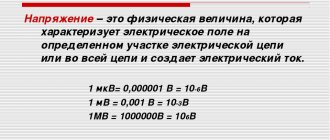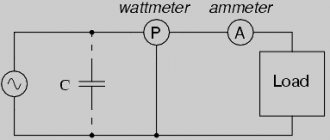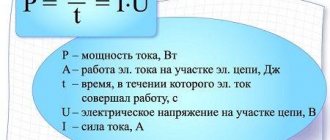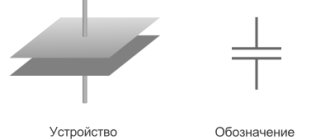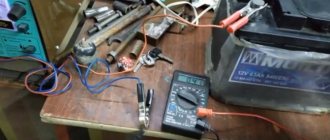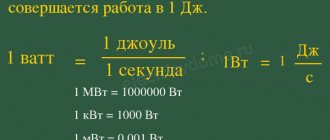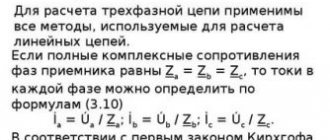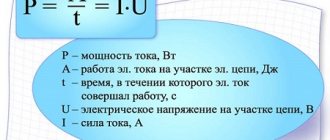Voltage, resistance, current and power - basic electrical quantities
In electrical engineering, it makes no sense to simply say “electricity.” Here it is always necessary to specify what exactly we are talking about. We can mean the electrical charge of a capacitor, the voltage in the socket, the current flowing through the wires, or, for example, the power that the electric meter in our apartment has generated in a month.
In any case, there is no such quantity as electricity, there is a quantity of “amount of electricity”, correctly called electric charge, which is measured in coulombs. This is an electric charge - it moves along the wires, accumulates on the capacitor plates, is periodically present at the terminals (at least on the phase wire) of the socket, and moves in the form of current when the electrical network performs work. Basic electrical quantities are somehow related to charge. We will talk about these quantities today.
Voltage
Electrical voltage U is measured between two points in a circuit. In order for a stable alternating or direct voltage to begin to be present in a closed circuit, a current source is needed that could ensure the maintenance of this voltage at the ends of the circuit. This source will serve as a source of EMF - electromotive force, which, like voltage, is measured in volts.
If such a source is connected to a closed circuit, then, firstly, voltage will be present between the terminals of the source, that is, at the ends of the circuit, and secondly, at the ends of all sections of this circuit, if it is conditionally divided into parts.
At each moment of time, the electrical voltage acting on one or another section of the circuit may have a different value than at the previous moment, if the circuit is powered by a source of variable EMF, or the same value if it is a source of constant EMF, and the circuit, accordingly, is a direct current circuit.
The voltage at the ends of a direct current circuit is like the difference in heights on the side of a mountain, and the charge under these conditions is like water raised to a height, only in relation to the electric field this difference is called the difference in electric potentials, since there is no talk of a gravitational field here.
The potential difference between two points is equal to 1 volt if, in order to move a charge of 1 coulomb from one point to another, 1 joule of work must be done on it. A volt is also equal to the electrical voltage that causes a direct current of 1 ampere at a power of 1 watt in an electrical circuit, but more on that later.
Current
When an electrical voltage is present at the ends of a section of a circuit (conductor), that is, when there is a difference in electrical potential, this means that an electric field operates in the conductor (along the length of the section in question). An electric field acts as a force on charged particles.
In metals, for example, free electrons are carriers of a negative charge and can go into translational motion if they suddenly find themselves in an external electric field, the source of which in this case is the source of emf. When electrons are set in motion by an electric field, they become a moving charge, that is, an electric current I.
The amount of charge is measured in coulombs, and the current characterizes the speed at which the charge moves through the cross section of the conductor (per unit time). When an electric charge of one coulomb passes through the cross-section of a conductor in one second, the current in the conductor is 1 ampere. In analogy with water, the more water passes through the cross-section of the pipe per second, the greater the current.
Resistance
Under the influence of electrical voltage, a charge moves through the cross-section of a conductor, forming a current, but it does not move unimpeded. Since we began to consider a metal conductor, we will continue with it.
Electrons in a conductor, moving under the influence of an electric field, encounter obstacles inside the conductor - atoms of the crystal lattice, as well as each other, due to the chaotic component (thermal) of the movement of electrons and vibrations of atoms.
These obstacles provide a kind of resistance, slow down the electrons, and reduce the current compared to the value to which it could develop if these obstacles were not there. But this kind of resistance R in real conductors (circuits) always exists.
This quantity is called electrical resistance in electrical engineering. Electrical resistance is measured in ohms. One ohm is equal to the electrical resistance of a section of an electrical circuit between the ends of which a constant electric current of 1 ampere flows with a voltage at the ends of 1 volt.
The greater the resistance that characterizes a given conductor, the smaller the current will be at the same voltage at the ends of this conductor. This dependence is called Ohm's law for a section of an electrical circuit: the amount of current in a section of a circuit is directly proportional to the voltage at the ends of this section and inversely proportional to the electrical resistance of a given section of the circuit.
Power
Speaking about an electrical circuit, voltage, resistance and current, it is impossible not to complete the topic of basic electrical quantities with a story about electrical power P. When, under the influence of voltage, a current is established in the circuit and continues to flow, the source of emf does work A on the circuit.
Essentially, work is done by an electric field on an electric charge that moves in this field. The amount of work done depends on the potential difference that the charge has overcome and on the magnitude of this charge. The faster the work was done, the higher the power of the process.
In the case of current, we usually talk about the power of the source that performed the work, as well as the power of the consumer (circuit). Electrical power expended to perform useful work is measured in watts. For any type of energy, not only electrical energy, 1 watt is defined as the power at which 1 joule of work is done in 1 second of time.
AC single phase voltage
In circuits for alternating current, completely different phenomena and processes occur; different laws apply to them. There are the following main types:
- Instantaneous (potential difference in a specific period of time: u = u (t)).
- Amplitude value (the maximum value of instantaneous U at a moment in time: u (t) = Um * sin (wt + f), where w is the angular frequency, t is a specific moment in time and f is the angle of the initial phase of the voltage).
- Average value (for a sine wave equals zero).
- Root mean square - Uq (U for the entire period of oscillation and for a sinusoid has the form: Uq = 0.707 * Um).
- Average rectified - Uv (average value of the module U: Um is approximately equal to 0.9 * Uq).
In 3-phase current circuits, there are 2 types of voltages: linear (phase-phase) and phase (phase-zero). When connected in a triangle circuit, the phase and linear U are equal. In the case of a star connection, the phase connection is 1.732050808 times less than the linear connection.
Current unit
Electrical parameters are studied as part of school programs. After exams, scientific definitions and formulas are quickly forgotten. Meanwhile, basic knowledge in the relevant field is needed not only by specialists and radio amateurs. They will be useful to ordinary users for connecting household appliances and solving other practical problems. This publication explains what a unit of current is.
About electric current
To facilitate understanding of the topic, you can use analogues (comparisons) from the outside world. Electrical quantities are sometimes explained using the example of a conventional pipeline:
- the flow of electrons is similar to the movement of a liquid;
- voltage (potential difference) – different pressure levels;
- as the cross-section of the conductor decreases, the current resistance increases - in the same way, the pressure has to be increased to move more water per unit of time.
Through the transparent walls you can observe the movement of the liquid flow. The presence of visual markers—contaminants—will simplify the visual experiment. However, the most keen-sighted person is not able to see the movement of microscopically small electrons.
However, it is the movement of a stream of charged particles that is an electric current. Why does such an action, even after a long period of experiment, not change the mass (size) of individual sections of the conductor?
As in the case of observation, the answer to the question is explained by the very small magnitude of the parameters under consideration. Electrons can be compared to ants. When moving to another “house”, the old anthill retains its size (shape). Likewise, the mass of the conductor will not change noticeably even if particles with electrical charges are completely removed from it.
What is the unit of current?
Below are the main parameters of a typical electrical circuit (standard symbols for formulas and abbreviated names are given in parentheses):
- units of current (I) – Amperes (A);
- voltage (U) – Volts (V);
- resistance (R) – Ohms (Ohm).
To complete the study, it is necessary to remember the quantitative indicator, power (W). It is measured in Watts (W).
If we continue the analogy with water, we can draw several important intermediate conclusions. To pass more liquid (electrons), the diameter of the pipe (conductor) is increased. This solution is accompanied by an increase in current. Voltage is measured by the potential difference between two points in a circuit. To increase it, the charge ratio is changed as needed.
Resistance prevents the passage of electrons. This process is accompanied by the conversion of electrical energy into thermal energy. In some devices, this feature performs useful functions.
Power consumption can be compared to the amount of water that flows through a certain section of the transport system per unit of time.
Ampere – SI unit of current measurement
According to the most popular international standard (SI) for direct current, one ampere (1A) corresponds to the passage of a unit charge (1 coulomb) in 1 s:
Another basic definition is created with the additional use of mechanical components. In accordance with it, a similar current creates an interaction force of 2 * 10-7 Newtons for each linear meter of a structure consisting of two parallel conductors. This means placing such a device in a neutral environment (vacuum), completely isolated from external electromagnetic radiation.
Formulas for calculating current characteristics
If a direct current source is connected to the conductor, the basic parameters can be calculated using the classical formula. Current in amperes is equal to voltage in volts divided by electrical resistance in ohms:
The power dependence is displayed as follows:
A simple transformation can be used to calculate other quantities:
- R=U/I=U2/P=P/I2;
- U= √P*R=I*R=P/U;
- P=I2*R=U2/I=U*I.
For your information. In AC circuits, the sinusoidal waveform is taken into account. Resistive loads (capacitors, coils) create a phase shift between voltage and current.
Current strength - what it is equal to, in what units it is measured, how to find current strength using the formula
As has already become clear, the strength of an electric current is a physical quantity that shows the charge that passes through a conductor per unit time. The basic formula for calculating it looks like this: I = q/t, where q is the charge that flows along the conductor in coulombs, and t is the time interval in seconds.
You can also calculate the strength of electric current using Ohm's law. It states that this value is equal to the network voltage in volts divided by its resistance in ohms. In this regard, there is a formula of this kind - I = U/R. This law is applicable for calculating DC values.
To calculate the variable parameters of electricity, you need to divide the values found by the square root of two.
For your information! This is a more practical measurement method and must be used frequently since all appliances in the home or office are powered by outlets that supply alternating current. This is done because it is easier to work with and more convenient to transform.
Ohm's law in the table
Important! A clear example of the operation of alternating electric current can be observed when fluorescent lamps are turned on. Until they light up completely, they will blink because the current moves back and forth in them.
The unit of current is ampere. It is defined as the strength of a constant current that passes through infinite parallel conductors of the smallest circular cross-section (with a minimum circular cross-sectional area), separated by 1 meter and located in an airless vacuum space. This interaction over one meter of length of these conductors is equal to 2 × 10 to the minus 7th power of Newton. If one coulomb of charge passes through a conductor in one second of time, then the current in it is equal to one ampere.
You might be interested in what power is the 16a machine designed for?
Rechargeable batteries are secondary sources, but are inextricably linked to batteries
Effect of current on different materials
The same current has different effects when passing through different materials. Metals, for example, have good conductivity. Impurities increase resistance, so to improve economic performance, power lines are made from well-purified copper. Polymer compounds are dielectrics and are often used to create insulation.
Water conducts electricity due to the ions it contains. This property is used for filtration, creating thin coatings and autonomous power supplies. It is enough to lower plates with opposite charges into the liquid to ensure the movement of particles in opposite directions.
A weak electric current stimulates brain activity and has a stimulating effect on the skin. Specialized devices are used in medical institutions and beauty salons. High current is dangerous to humans, so appropriate protective equipment should be used when working with electricity.
Electricity
Electricity is a natural phenomenon that confirms the existence, interaction and movement of electrical charges. Electricity was first discovered back in the 7th century BC. Greek philosopher Thales. Thales noticed that if a piece of amber is rubbed on wool, it begins to attract light objects. Amber in ancient Greek is electron.
This is how I imagine Thales sitting, rubbing a piece of amber on his himation (this is the woolen outerwear of the ancient Greeks), and then with a puzzled look he watches as hair, scraps of thread, feathers and scraps of paper are attracted to the amber.
This phenomenon is called static electricity . You can repeat this experience. To do this, rub a regular plastic ruler thoroughly with a woolen cloth and bring it to the small pieces of paper.
It should be noted that this phenomenon has not been studied for a long time. And only in 1600, in his essay “On the Magnet, Magnetic Bodies and the Great Magnet - the Earth,” the English naturalist William Gilbert introduced the term electricity. In his work, he described his experiments with electrified objects, and also established that other substances can become electrified.
Then, for three centuries, the most advanced scientists in the world researched electricity, wrote treatises, formulated laws, invented electrical machines, and only in 1897 Joseph Thomson discovered the first material carrier of electricity - the electron, a particle that makes electrical processes in substances possible.
An electron is an elementary particle, has a negative charge approximately equal to -1.602 10 -19
Cl (Pendant).
Denoted e
or
e –
.
Voltage
To make charged particles move from one pole to another, it is necessary to create a potential difference or – Voltage – . Voltage unit – Volt ( V
or
V
).
In formulas and calculations, voltage is denoted by the
letter V. To obtain a voltage of 1 V, you need to transfer a charge of 1 C between the poles, while doing 1 J (Joule) of work.
For clarity, imagine a water tank located at a certain height. A pipe comes out of the tank. Water under natural pressure leaves the tank through a pipe. Let's agree that water is an electric charge , the height of the water column (pressure) is voltage , and the speed of water flow is electric current .
Thus, the more water in the tank, the higher the pressure. Similarly from an electrical point of view, the greater the charge, the higher the voltage.
Let's start draining the water, the pressure will decrease. Those. The charge level drops - the voltage decreases. This phenomenon can be observed in a flashlight; the light bulb becomes dimmer as the batteries run out. Please note that the lower the water pressure (voltage), the lower the water flow (current).
Formula
This is a phenomenon studied in electrostatics, magnetostatics, electrodynamics and electrical circuits. Equal to the amount of charge divided by time, voltage divided by conductor resistance. Calculated using Ohm's law for a complete electrical circuit. To do this, it is necessary to divide the voltage source into the expression of the resistance of external network elements and the internal resistance of the voltage source. In this case, the value of the electromotive force of the voltage source can be less or more than the resistance, if the current energy depends on the size of the load or not.
Note! It is worth pointing out that the electric current can be found by multiplying the charge, its concentration, the average voltage and the cosine of the area angle if the surface has a flat shape. Also, the electric current can be found by multiplying all the previously mentioned elements and the integral over the surface.
Measurement Formula
Electricity
Electric current is a physical process of directed movement of charged particles under the influence of an electromagnetic field from one pole of a closed electrical circuit to another. Charge-carrying particles can include electrons, protons, ions and holes. Without a closed circuit, no current is possible. Particles capable of carrying electrical charges do not exist in all substances; those in which they exist are called conductors and semiconductors . And substances in which there are no such particles are dielectrics .
It is generally accepted that the direction of current is from plus to minus, while electrons move from minus to plus!
The unit of current measurement is Ampere ( A
).
In formulas and calculations, current strength is denoted by the
letter I. A current of 1 Ampere is generated when a charge of 1 Coulomb (6.241·10 18 electrons) passes through a point in an electrical circuit in 1 second.
Let's look again at our water-electricity analogy. Only now let’s take two tanks and fill them with an equal amount of water. The difference between the tanks is the diameter of the outlet pipe.
Let's open the taps and make sure that the flow of water from the left tank is greater (the diameter of the pipe is larger) than from the right. This experience is clear evidence of the dependence of flow speed on pipe diameter. Now let's try to equalize the two flows. To do this, add water (charge) to the right tank. This will give more pressure (voltage) and increase flow rate (current). resistance acts as the pipe diameter .
The experiments carried out clearly demonstrate the relationship between voltage , current and resistance . We'll talk more about resistance a little later, but now a few more words about the properties of electric current.
If the voltage does not change its polarity, plus to minus, and the current flows in one direction, then it is a direct current and, accordingly, a constant voltage . If the voltage source changes its polarity and the current flows in one direction, then in the other, this is already alternating current and alternating voltage . Maximum and minimum values (indicated on the graph as Io
) are
amplitude or peak current values. In home sockets, the voltage changes its polarity 50 times per second, i.e. the current oscillates here and there, it turns out that the frequency of these oscillations is 50 Hertz, or 50 Hz for short. In some countries, for example in the USA, the frequency is 60 Hz.
Current calculation
The current strength is determined using special instruments or using formulas when there are other indicators of the operation of the electrical circuit. Basic formula for calculating current:
Electric current can be constant or alternating. An example of direct current is a battery, and an example of alternating current is the current in a household outlet. All devices and lighting are powered by alternating current. Alternating current differs from direct current in that it transforms better.
Alternating current is most often used both in everyday life and in industrial enterprises. According to Ohm's law, the current strength of a section of a circuit is calculated as follows:
That is, the current strength depends directly on the voltage \(U\), and inversely depends on the resistance of the circuit section \(R\).
Is it difficult to figure it out on your own?
Try asking your teachers for help
The current strength in a closed circuit is calculated as follows:
where \(E\) – electromotive force, V; \(R\) – external resistance, Ohm; \(r\) – internal resistance, Ohm;
The main ways to determine current strength using instruments:
- magnetoelectric measuring method. It has high sensitivity and accuracy of readings with low power consumption. This method is used only to determine direct current;
- electromagnetic method. This method consists of determining the strength of alternating or direct current by converting an electromagnetic field signal into a magnetic signal, which is picked up by a sensor;
- indirect method. It consists of determining the voltage with a voltmeter and then calculating the current using formulas.
To determine the strength of a small current, a milliammeter or microammeter is used. There is also such a device as a galvanometer. In this case, the devices are connected in parallel or in series.
In practice, current does not need to be determined as often as voltage or resistance. But without determining its value, it is impossible to calculate power consumption.
Didn't find the information you need?
Order suitable material on our service. Post a task - the system will automatically send it out within 59 seconds. Choose the right expert and he will save you the hassle of studying.
Low Price Guarantee
All work is carried out without intermediaries, so the prices will pleasantly surprise you.
Improvements and consultations are included in the price
As part of the task, they are free and completed within the agreed time frame.
We will refund money for uncompleted tasks
If the expert fails, we guarantee a 100% refund.
Technical support 7 days a week
Our managers work on weekends and holidays to promptly answer your questions.
Thousands of verified experts
We select only reliable performers - professionals in their field. All of them have higher education with diploma grades of “good” and “excellent”.
Money back guarantee
The expert received the money but did not complete the work? Not with us!
Money is kept on your balance during the work on the task and the warranty period
Money back guarantee
In case something goes wrong, we guarantee a refund of the full amount paid
Resistance
Electrical resistance is a physical quantity that determines the property of a conductor to impede (resist) the passage of current. The unit of resistance is Ohm (denoted by Ohm
or the Greek letter omega
Ω
).
In formulas and calculations, resistance is denoted by the
letter R. A conductor has a resistance of 1 ohm to the poles of which a voltage of 1 V is applied and a current of 1 A flows.
Conductors conduct current differently. Their conductivity depends, first of all, on the material of the conductor, as well as on the cross-section and length. The larger the cross-section, the higher the conductivity, but the longer the length, the lower the conductivity. Resistance is the inverse concept of conductivity.
Using the plumbing model as an example, resistance can be represented as the diameter of the pipe. The smaller it is, the worse the conductivity and the higher the resistance.
The resistance of a conductor manifests itself, for example, in the heating of the conductor when current flows through it. Moreover, the greater the current and the smaller the cross-section of the conductor, the stronger the heating.
Basic electrical quantities
Let's consider the basic electrical quantities that we study first at school, then in secondary and higher educational institutions. For convenience, we will summarize all the data in a small table. Definitions of individual quantities will be given after the table in case of any misunderstandings.
| Magnitude | SI unit | Name of electrical quantity |
| q | Kl - pendant | charge |
| R | Om - om | resistance |
| U | V – volt | voltage |
| I | A – ampere | Current strength (electric current) |
| C | F – farad | Capacity |
| L | Mr. Henry | Inductance |
| sigma | CM - Siemens | Electrical conductivity |
| e0 | 8.85418781762039*10 -12 F/m | Electrical constant |
| φ | V – volt | Electric field point potential |
| P | W – watt | Active power |
| Q | VAR – volt-ampere-reactive | Reactive power |
| S | Va – volt-ampere | Full power |
| f | Hz - hertz | Frequency |
There are decimal prefixes that are used in the name of the quantity and serve to simplify the description. The most common of them are: mega, miles, kilo, nano, pico. The table shows other prefixes, except those mentioned.
| Decimal multiplier | Pronunciation | Designation (Russian/international) |
| 10 -30 | cuecto | q |
| 10 -27 | ronto | r |
| 10 -24 | iocto | and/y |
| 10 -21 | zepto | s/z |
| 10 -18 | atto | a |
| 10 -15 | femto | f/f |
| 10 -12 | pico | p/p |
| 10 -9 | nano | n/n |
| 10 -6 | micro | μ/μ |
| 10 -3 | Milli | m/m |
| 10 -2 | centi | c |
| 10 -1 | deci | d/d |
| 10 1 | soundboard | yes/da |
| 10 2 | hecto | g/h |
| 10 3 | kilo | k/k |
| 10 6 | mega | M |
| 10 9 | giga | G/G |
| 10 12 | tera | T |
| 10 15 | peta | P/P |
| 10 18 | exa | E/E |
| 10 21 | zeta | Z/Z |
| 10 24 | yotta | Y/Y |
| 10 27 | Ronna | R |
| 10 30 | quecca | Q |
A current strength of 1A is a value equal to the ratio of a charge of 1 C passed through a surface (conductor) in 1 s of time to the time the charge passes through the surface. For current to flow, the circuit must be closed.
Current strength is measured in amperes. 1A=1Kl/1c
In practice there are
Electric voltage is the potential difference between two points in an electric field. The magnitude of electrical potential is measured in volts, therefore voltage is measured in volts (V).
1 Volt is the voltage that is necessary to release 1 Watt of energy in a conductor when a current of 1 Ampere flows through it.
In practice there are
Electrical resistance is the characteristic of a conductor that prevents electric current from flowing through it. It is defined as the ratio of the voltage at the ends of the conductor to the current in it. Measured in ohms (ohms). Within certain limits the value is constant.
1 Ohm is the resistance of a conductor when a direct current of 1A flows through it and a voltage of 1V arises at the ends.
From the school physics course we all remember the formula for a homogeneous conductor of constant cross-section:
R=ρlS – the resistance of such a conductor depends on the cross-section S and length l
where ρ is the resistivity of the conductor material, tabular value.
Between the three quantities described above, Ohm's law exists for a DC circuit.
The current in the circuit is directly proportional to the voltage in the circuit and inversely proportional to the resistance of the circuit - Ohm's law.
Electrical capacitance is the ability of a conductor to accumulate electrical charge.
Capacitance is measured in farads (1F).
1F is the capacitance of a capacitor between the plates of which a voltage of 1V occurs when charged at 1C.
In practice there are
Inductance is a quantity that characterizes the ability of a circuit through which electric current flows to create and accumulate a magnetic field.
Inductance is measured in henries.
1H is a value equal to the self-inductive emf that occurs when the current in the circuit changes by 1A within 1 second.
In practice there are
Electrical conductivity is a value indicating the ability of a body to conduct electric current. Reciprocal of resistance.
Electrical conductivity is measured in siemens.
Bookmark or share with friends
Source
Power
Electrical power is a physical quantity that determines the rate of electricity conversion. For example, you have heard more than once: “a light bulb is so many watts.” This is the power consumed by the light bulb per unit of time during operation, i.e. converting one type of energy into another at a certain speed.
Sources of electricity, such as generators, are also characterized by power, but already generated per unit of time.
The unit of power measurement is Watt (denoted by W
or
W
).
In formulas and calculations, power is denoted by the
letter
P. For alternating current circuits, the term is used Apparent power , the unit of measurement is Volt-ampere ( VA
or
V A
) , denoted by the letter
S.
And finally about the Electric Circuit . This circuit is a certain set of electrical components capable of conducting electric current and interconnected accordingly.
What we see in this image is a basic electrical device (flashlight). Under voltage U
(B) a source of electricity (battery), through conductors and other components with different resistances
R
(Ohm), an electric current
I
(A) flows from plus to minus, causing the light bulb to glow with power
P
(W). Do not pay attention to the brightness of the lamp, this is due to poor pressure and low water flow of the batteries.
The flashlight shown in the photo is assembled on the basis of the “Znatok” construction set. This construction set allows a child to learn the basics of electronics and the operating principles of electronic components in a playful way. Supplied in the form of sets with different numbers of patterns and different levels of complexity.
Source
Current sources
An electric current source is an electrical device that converts a certain type of energy into electrical energy. Such devices are divided into physical and chemical.
The operating principle of chemical sources is based on the conversion of chemical energy into electrical energy. This transformation occurs independently and does not require outside participation. Depending on the renewability of elements and the type of reactions, they are divided into:
- Primary (batteries) Primary sources cannot be used a second time if they are discharged, since the chemical reactions occurring in them are irreversible. They are divided into fuel and semi-fuel cells. Fuel batteries are similar to batteries, but the chemicals in them are charged separately, and they come out as products of a chemical reaction. This helps them work for a long time. Semi-fuel includes one of the chemical elements, and the second is gradually added throughout use. Their service life is determined by the supply of non-renewable substance. If regeneration through charging is possible for such an element, then it resumes its capabilities as a battery.
Batteries - as primary chemical sources of current
- Secondary (batteries) undergo a charging cycle before use. The charge they receive during the process can be transported along with the devices. After the charge is consumed, it can be regenerated due to charging and the reversibility of the chemical reaction. Also classified as secondary are renewable elements that are mechanically or chemically charged and restore their ability to power devices. They are designed in such a way that after a certain period of time they require replacement of certain parts in order for the reaction to continue.
Types of electric power sources
Important! It should be understood that the division into batteries and accumulators is conditional. The properties of the battery can be manifested, for example, in alkaline batteries, which can be revived at a certain state of charge.
You might be interested in this: Features of calculating short-circuit currents
Also, according to the type of reagents, chemical sources are divided into:
- Acidic.
- Saline.
- Alkaline.
Physical sources of electric current are based on the conversion of mechanical, as well as nuclear, thermal or light energy into electrical energy.
Industrial three-phase current generator
